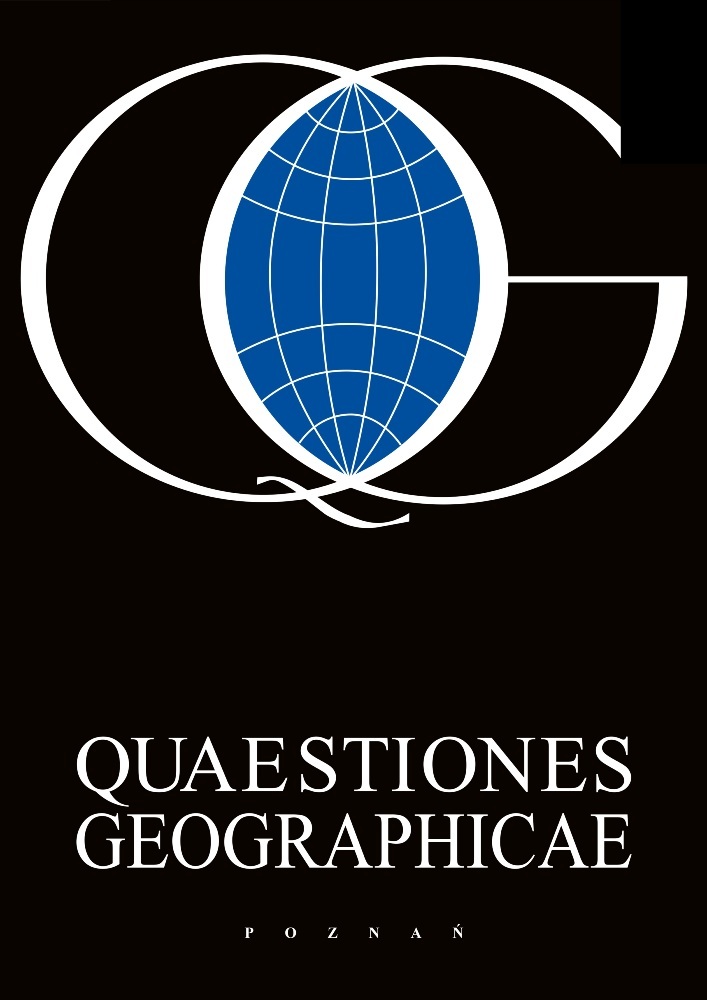Abstract
This paper discusses fluctuations in spring water temperature and its correlation to climate and aquifer characteristics. Data from nine springs in the Gryżynka River catchment (Polish Plain) were taken monthly (November 2005 to October 2010). The springs examined in this study are characterised by significant thermal inertia in contrast to air temperature, that is expressed in small temperature amplitudes that range from 1.3°C to 2.3°C. The average temperature of the springs is about 9°C. The research proved that observed groundwater temperature variations on the surface resulted mainly from atmospheric conditions, especially air temperature. The highest water temperatures (up to 10°C) were observed during late summer and early autumn, and the lowest temperature (7.7°C) was observed at the end of the winter period. The range of spring water temperature variability may reflect amount of water contribution from local water recharge in the spring vicinity.
References
Aldwell C.R., Burdon D.J., 1986. Temperature of infiltration and groundwater. In: Proceedings of Conjuctive Water UseSymposium. Budapest, IAHS Publ. no. 156.
Baena C.L., Andreo B., Mudry J., Cantos F.C., 2009. Groundwater temperature and electrical conductivity as tools to characterize flow patterns in carbonate aquifers: The Sierra de las Nieves karst aquifer, southern Spain. HydrogeologyJournal 17: 843-853.
Becker M.W., Georgian T., Ambrose H., Siniscalchi J., Fredrick K., 2004. Estimating flow and flux of ground water discharge using water temperature and velocity. Journalof Hydrology 296: 221-233.
Bender S., Einsiedl F., Wohnlich S., 2001. Scheme for development of monitoring networks for springs in Bavaria, Germany. Hydrogeology Journal 9: 208-216.
Bundschuh J., 1993. Modeling annual variations of spring and groundwater temperatures associated with shallow aquifer systems. Journal of Hydrology 142: 427-444.
Bundschuh J., 1995. Assessing the contamination potential of groundwater using its temporal temperature variations. In: Proceedings of Models for Assessing and MonitoringGroundwater Quality Symposium. Boulder, IAHS Publ. no. 227.
Chełmicki W., Jokiel P., Michalczyk Z., Moniewski P., 2011. Distribution, discharge and regional characteristics of springs in Poland. Episodes 34: 244-256.
Graf R., 2006. Komentarz do mapy hydrologicznej w skali 1:50 000. N-33-139-A Lubrza. (Coments to hydrological map 1:50 000. N-33-139-A Lubrza). GEOMAT, Poznań.
James E.R., Manga M., Rose T.P., Hudson G.B., 2000. The use of temperature and the isotopes of O, H, C, and noble gases to determine the pattern and spatial extent of groundwater flow. Journal of Hydrology 237: 100-112.
Leaver J.D., Unsworth C.P., 2007. System dynamics modeling of spring behavior in the Orakeikorako geothermal field, New Zealand. Geothermics 36: 101-114.
Malard F., Chapuis R., 1995. Temperature logging to describe the movement of sewage-polluted surface water infiltrating into a fractured rock aquifer. Journal of Hydrology 173: 191-217.
Manga M., 1998. Advective heat transport by low temperature discharge in the Oregon Cascades. Geology 26: 799-802.
Manga M., 1999. On the timescales characterizing groundwater discharge at springs. Journal of Hydrology 219: 56-69.
Manga M., 2001. Using springs to study groundwater flow and active geologic processes. Annual Reviews in EarthPlanetary Sciences 29: 201-228.
Manga M., Kirchner J.W., 2004. Interpreting the temperature of water at cold springs and the importance of gravitational potential energy. Water Resources Research. 40, W05110, DOI 10.1029/2003WR002905.
Moniewski P., 2004. Źródła okolic Łodzi (Springs nearby city of Łódź). Acta Geographica Lodziensia 87: 1-140.
Musgrove M., Stern L.A., Banner J.L., 2010. Springwater geochemistry at Honey Creek State Natural Area, central Texas: Implications for surface water and groundwater interaction in a karst aquifer. Journal of Hydrology 388: 144-156.
Szczucińska A.M., 2009. Wypływy wód podziemnych w RynnieGryżyńsko-Grabińskiej (Groundwater outflows in the Gryżyna-Grabin tunnel valley). Wyd. Bogucki, Poznań, 117 pp.
Szczucińska A.M., in press. Spatial distribution and hydrochemistry of springs and seepage springs in the Lubuska Upland of western Poland. Hydrology Research. Doi: 10.2166/nh.2013.249.
Szczucińska A.M., Marciniak M., 2008. Zones of groundwater outflow in the Gryzyna-Grabin tunnel valley as an example of groundwater outflows on the Polish Plain. In: G. Migiros, G. Stamatis, G. Stournaras (eds.), Proceedingsof 8th International Hydrogeological Congress of Greece. The Geological Society of Greece, Athens: 863-868.
Szczucińska A.M., Siepak M., Zioła-Frankowska A., Marciniak M, 2010. Seasonal and spatial changes of metal concentrations in groundwater outflows from porous sediments in the Gryżyna-Grabin Tunnel Valley in western Poland. Environmental Earth Sciences 61: 921-930.
Taniguchi M., Uemura T., 2005. Effects of urbanization and groundwater flow on the subsurface temperature in Osaka, Japan. Physics of the Earth and Planetary Interiors 152: 305-313.
Taylor C.A., Stefan H.G., 2009. Shallow groundwater temperature response to climate change and urbanization. Journal of Hydrology 375: 601-612.
Wampler P.J., Sisson A.J., 2010. Spring flow, bacterial contamination, and water resources in rural Haiti. EnvironmentalEarth Science. DOI: 10.1007/s12665-010-0645-9.
Woś A., 1999. Klimat Polski (Climate of Poland). PWN, Warszawa, 130 pp.
License
This content is open access.
